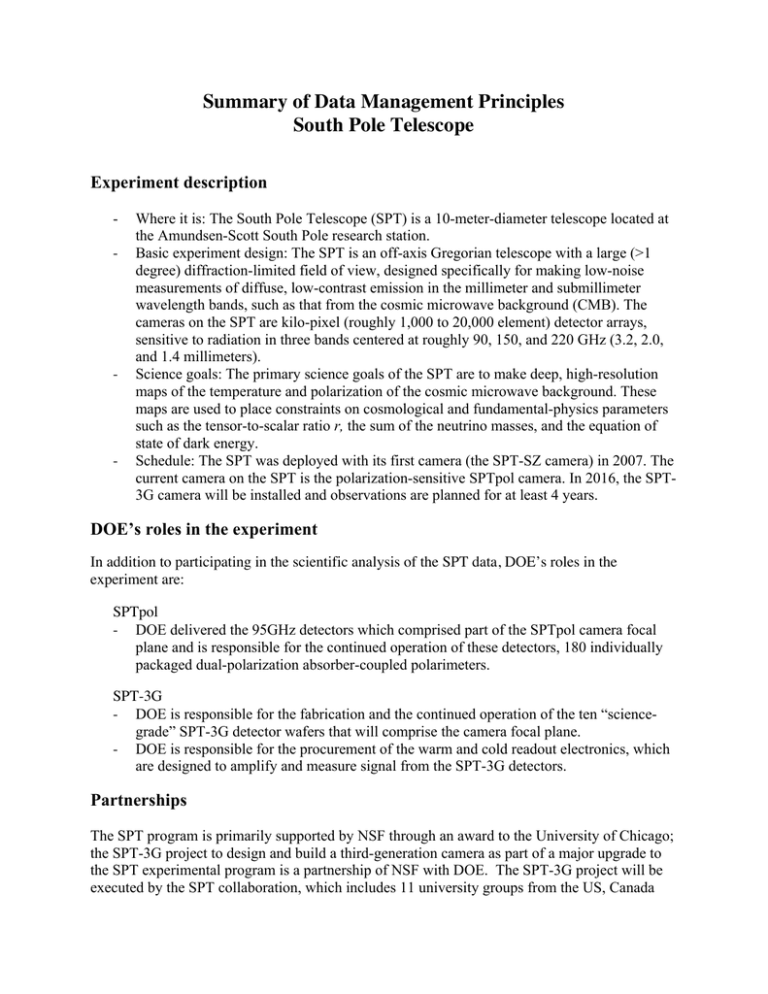Summary for HEP of Data Management
advertisement

Summary of Data Management Principles South Pole Telescope Experiment description - - - Where it is: The South Pole Telescope (SPT) is a 10-meter-diameter telescope located at the Amundsen-Scott South Pole research station. Basic experiment design: The SPT is an off-axis Gregorian telescope with a large (>1 degree) diffraction-limited field of view, designed specifically for making low-noise measurements of diffuse, low-contrast emission in the millimeter and submillimeter wavelength bands, such as that from the cosmic microwave background (CMB). The cameras on the SPT are kilo-pixel (roughly 1,000 to 20,000 element) detector arrays, sensitive to radiation in three bands centered at roughly 90, 150, and 220 GHz (3.2, 2.0, and 1.4 millimeters). Science goals: The primary science goals of the SPT are to make deep, high-resolution maps of the temperature and polarization of the cosmic microwave background. These maps are used to place constraints on cosmological and fundamental-physics parameters such as the tensor-to-scalar ratio r, the sum of the neutrino masses, and the equation of state of dark energy. Schedule: The SPT was deployed with its first camera (the SPT-SZ camera) in 2007. The current camera on the SPT is the polarization-sensitive SPTpol camera. In 2016, the SPT3G camera will be installed and observations are planned for at least 4 years. DOE’s roles in the experiment In addition to participating in the scientific analysis of the SPT data, DOE’s roles in the experiment are: SPTpol - DOE delivered the 95GHz detectors which comprised part of the SPTpol camera focal plane and is responsible for the continued operation of these detectors, 180 individually packaged dual-polarization absorber-coupled polarimeters. SPT-3G - DOE is responsible for the fabrication and the continued operation of the ten “sciencegrade” SPT-3G detector wafers that will comprise the camera focal plane. - DOE is responsible for the procurement of the warm and cold readout electronics, which are designed to amplify and measure signal from the SPT-3G detectors. Partnerships The SPT program is primarily supported by NSF through an award to the University of Chicago; the SPT-3G project to design and build a third-generation camera as part of a major upgrade to the SPT experimental program is a partnership of NSF with DOE. The SPT-3G project will be executed by the SPT collaboration, which includes 11 university groups from the US, Canada and the UK, 4 US HEP laboratory partners and NIST. The SPT-3G project includes the construction and deployment of the new camera. The scope of the project is covered by the Project Execution Plan (PEP) and does not include SPT-3G operations. The SPT program includes an ongoing science program using data collected from the initial SPT-SZ camera from 2007 to 2011 as well as several ancillary follow-up data sets. It also includes the continued operation of SPT with SPTpol camera and the ongoing analysis of the SPTpol data, which will continue to be collected until the SPT-3G camera is deployed. Organization – Agency/Lab level - DOE deliverables and responsibilities are managed by Argonne; the science collaboration and operations are independent. NSF is the primary agency for the SPT program, which is funded through an award to The University of Chicago. The lead lab for DOE’s role is Argonne. Organization – Experiment level The SPT project is managed overall by J. Carlstrom (U. Chicago) serving as the SPT Director and W. Holzapfel (U.C. Berkeley) serving as the SPT Project Scientist. At the project and management “office” at Chicago there is a financial business manager, an administrative assistant who also handles procurements, and a full-time professional software engineer. The site operations regarding deployments and upgrades to the receiver are managed by B. Benson. The site logistics, including project management for new construction such as the ground shields is provided by E. Nichols under contract with Remote Science Services, LLC. Research Scientist T. Crawford manages the Data Management. Collaboration The core institutional partners in the SPT collaboration are Argonne National Laboratory, Case Western Reserve University, Chicago/KICP, CU Boulder, Harvard/CfA, McGill University, UC Berkeley, and UC Davis. In addition, collaborators primarily working on follow-up observations and analysis are spread over more than 30 institutions spanning the globe. Including postdocs and graduate students, the SPT collaboration consists of order 90 scientists. Senior members at the core SPT institutions are allowed to bring their postdocs and students on the collaboration. New senior members are invited by consensus of all established members. In general, new members are brought in when they have a clear role to play in the collaboration. Membership is thus limited; however, many collaborators participate in selected analysis through science working groups, often leading analysis in topics of their expertise, or leading follow-up observations. Data policy management Data policy is set by consensus of the collaboration, which includes university and lab partners. The collaboration – in particular the P.I. and data managers at the University of Chicago – bear the responsibility for making data public. Public data products are hosted on University of Chicago machines and on the NASA Legacy Archive for Microwave Background Data Analysis (LAMBDA) server. Data Description & Processing The primary data products produced by multi-element bolometer cameras on the SPT (including SPT-SZ, SPTpol, and SPT-3G) are 1) time series representing the voltage across each bolometer and ancillary time series data representing the position of the telescope, bolometer calibration data, and housekeeping information; 2) maps of the sky made from combining these timeordered data into an estimate of the sky temperature at every point observed by the camera in a single observation; and 3) final co-added maps made from many single observations of a given sky field. Software pipelines for processing the raw data products into individual observation maps and final coadded maps have been developed and extensively tested for SPT-SZ and SPTpol, and fully standardized formats for storage of the data are in place. The software and file formats for SPT-3G data will closely follow these earlier models. Raw data from the SPT-SZ and SPTpol cameras is stored in a custom format, originally developed for the CBI and DASI instruments. However, as soon as the data is transferred from the South Pole to the main SPT computers in Chicago, the raw data is converted into a universally readable FITS binary table extension format. These “intermediate data files” are the primary input to the main analysis pipelines. The single-observation maps are also stored in binary table extensions to FITS files. When a final, stable, fully coadded map is produced for wider distribution to the collaboration, it is stored in the primary array of a FITS file, with world coordinate system information and other documentation stored in header keywords (as in most traditional astronomical data). Auxiliary files relating to the individual-observation and final maps (such as noise properties and point-spread function or beam) are stored either in FITS files or ascii files, whichever is more appropriate. No Personally Identifiable Information will be collected or stored. Data Products and Releases Raw data from the SPT-SZ and SPTpol cameras is transferred from the South Pole to the main SPT computers in Chicago, converted to intermediate data files, and released to the collaboration daily. These data files are the primary input to the main analysis pipelines. Single-observation and coadded maps are custom-produced for specific science applications and are distributed to the collaboration as soon as they are available. Auxiliary data products (beams, bandpasses, etc.) are generated as needed (generally once per observing season) and are immediately available to the collaboration. Public releases occur in concordance with the publication of major science results, and the products are posted on a website with instructions. Plan for Serving Data to the Collaboration and Community The SPT collaboration is committed to making data accessible to the wider community in as useful a format as possible. When a particular analysis is submitted to a scientific journal and posted on the arXiv preprint server, any data products that result from that analysis are immediately made available on the SPT public website (http://pole.uchicago.edu) and are soon uploaded to the LAMBDA server (http://lambda.gsfc.nasa.gov). Examples of this are catalogs of galaxy clusters and emissive sources, measurements of the amplitude of the CMB power spectrum, and cosmological parameter constraints. Moreover, the SPT team has released maps of the SPT-SZ data, and is committed to releasing maps from the SPTpol and SPT-3G. Sharing of pre-release data will be arranged through memoranda of understanding among all parties. Plan for Archiving Data The archiving of SPT-SZ, SPTpol, and SPT-3G data takes place on two levels. The raw data, which is not of particular utility to the broader scientific community, is maintained in three locations. Two copies of the data exist on hard drives accessible to the SPT collaboration for analysis: one in Chicago and one at the South Pole. A third copy of the full data is maintained on tape at the National Energy Research Scientific Computing (NERSC) Center. The data products of more interest to the community, namely the sky maps and associated data products, will be archived primarily on the LAMBDA server. A second copy of all of these products will be maintained, at least for the duration of the current SPT project, on the public SPT website. Plan for Making Data Used in Publications Available When a particular analysis is submitted to a scientific journal and posted on the arXiv preprint server, any data products that result from that analysis are immediately made available on the SPT public website (http://pole.uchicago.edu) and are soon uploaded to the LAMBDA server (http://lambda.gsfc.nasa.gov). Examples of this are catalogs of galaxy clusters and emissive sources, measurements of the amplitude of the CMB power spectrum, and cosmological parameter constraints. Responsiveness to SC Statement on Digital Data Management This data management plan fully follows SC Statement on Digital Data Management.




